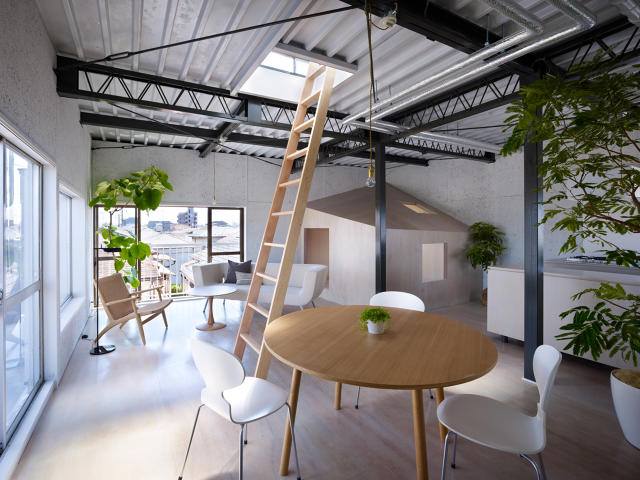Is The Open-Office Trend Reversing Itself?
Employers spent years knocking down their walls. Now they are slowly building them back up.
EmUne ployers spent years knocking down their walls. Now they are slowly building them back up.
Une réflexion sur le fait que l'open-space a été une mode et peut devenir insupportable, que les bureaux cloisonnées (type commission européenne) ne conviennent pas... Sans doute un point à gagner en cas de projet tertiaire à réaliser... (FAAST).
Employers spent years knocking down their walls. Now they are slowly building them back up.
In an effort to conserve space, improve employee communications, and save money, many companies became gung-ho about open-office designs in the last several years. At more and more workplaces today, you'll find workers crammed into cavernous (but beautiful) rooms without walls. Whether employees like these layouts is a contentious debate (as Fast Company staff had once, here).
Now the backlash against open offices has begun. Steelcase designs closed spaces to retrofit open offices so introverts don't hate them. Some tech companies are rethinking their open plans altogether. But few are quite ready to give up on the open office completely. Instead, companies seem to be looking for a middle ground.
Primo Orpilla, principal designer at San Francisco-based interior design firm O + A—a firm that has worked with big-name tech companies like Uber, Microsoft, and OpenTable—has seen the transition from closed to open offices and back again. "I think people jumped to open offices in 2008 and 2009. It was always popular among smaller gaming and social media companies," he says. "Then it caught on in 2009 and 2010, when not only Google had an open plan, but Facebook did too."

The office style appealed to tech companies, he says, because of the open plan's association with a startup atmosphere. That ethos eventually spread upward into larger tech companies as well. Plus, in the pricey Bay Area, it makes a lot of economic sense. If you can go from 250-square-feet per person to 110 or even less, it makes a big difference in the cost of office space.
Open offices do have other advantages. In certain settings, they improve communication and create a sense of camaraderie. But they also make it hard to concentrate for long periods of time, and it's difficult to adjust to an open office when you're used to having privacy. That's where the backlash comes in.
"Really the backlash I’ve seen in the last two or three years has been because a lot of these older companies are migrating to an open plan . . . where you're asking an older developer to sit on a 30 by 60 bench in a huge space," says Orpilla. "It's not only the noise but the line of sight. People get distracted by people walking by, and there’s an overall pollution of the culture."

So what does the new breed of office—a compromise between open and closed offices—look like? One of O + A's clients, a startup called Quid, designed its space with special "phone booth" rooms for when employees need quiet time. The office also has a lounge-like room called The Shelter, which has an open roof. That means it provides visual privacy, but not acoustic privacy. "It's a little bit of visual break. You don't have to put in the electrical and mechanical installations of a hard-walled office," says Orpilla. Conference rooms at Quid also vary in size, ranging from large rooms to rooms that fit just two to three people.
Yelp, another O + A client, switched offices in 2013. The company kept its open-office aesthetic, but like Quid, it tried to add in more private spaces. "There are so many different groups that have different expectations. Engineers love quiet spaces compared to the sales group. We try to balance it out. There are no private offices," says John Lieu, director of real estate and facilities at Yelp.
At Yelp's new-ish office, there are phone booth rooms, chill-out rooms, and a variety of conference rooms of different sizes. Lieu also took 35% of the conference rooms off Yelp's reservation system, so that there are always spots available.
Orpilla's advice for companies looking to adjust their open offices: have lots of variety and don't cram too many people into a small space. "If you over-densify and don’t complement it with right amount of small spaces, it's a problem," he says.
[Top Photo: Yuri_Arcurs/Getty Images]
http://www.fastcoexist.com/3046415/is-the-open-office-trend-reversing-itself?partner=rss&utm_source=feedburner&utm_medium=feed&utm_campaign=Feed%3A+fastcoexist%2Ffeed+%28Co.Exist%29
A découvrir aussi
- Flexible outlook: Modular design in Brazil
- How Heatherwick Studio Provides Small-Scale Encounters in a Large-Scale World
- Caisse d’Epargne Headquarters / Taillandier Architectes Associés
Inscrivez-vous au blog
Soyez prévenu par email des prochaines mises à jour
Rejoignez les 16 autres membres
